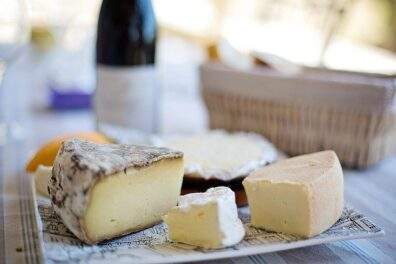A new episode of the Focus on Scotland series.
I had the pleasure to meet with someone who introduced us to some interesting hamper ideas with renowned (in their view at least) Scottish produce such as Arran chees, Highland Brie and Orkney Cheddar.
Having lived in Scotland for 10 years, in England for another 13 and I have never ever had the pleasure to be introduced to these unique cheeses.
The taste was absolutely unique; nothing to envy other internationally renowned brands. Yet, they came mostly from local, independent farms.
As soon as I started my research into the world of Scottish cheese, I came across a niche and quite a luxury, independent, family-run artisanal sector.
Scottish cheeses are, in fact, highly regarded and well-known within the UK and are considered a premium, artisan product.
Internationally, they are a niche superstar. Not a household name like Cheddar, not a posh name like Brie. We all know those gourmet celebrities. No, Scottish cheese is celebrated by cheese connoisseurs, speciality retailers, and in high-end hospitality, often winning major international awards that give it a powerful, if selective, global reputation.
My question is why we do not hear more about this important form of economic production that has met with strong internationalisation challenges, and how we can think of sustainable growth. In the context of current international shifting winds and market volatility, these questions deserve attention.

The Scottish Cheese Market: An analysis
Scottish artisan cheeses sit in a high-value niche that punches above its weight: awards, high-end listings and a strong domestic reputation drive demand. At the UK level, cheese exports recovered strongly in 2024 and continued to grow into 2025.
However, many practical barriers for small Scottish producers are regulatory and logistical rather than headline tariffs.
Recent policy progress on sanitary/phytosanitary (SPS) rules offers real hope to ease EU trade frictions, but scale, cost of compliance and distribution remain the main bottlenecks for artisan creameries.
Let’s take a look.
Export scale — the numbers
- UK cheese exports (2024): UK cheese exports reached £887 million in 2024 — the highest level since 2020 — with ~72% (£641m) of that value going to the EU. The USA remains a growing market (UK cheese exports there were ≈£75m in 2024).
- UK dairy export value (2024): Total UK dairy exports were about £1.8 billion in 2024, driven by growth in cheese and other higher-value dairy products.
- H1 2025 momentum: The first half of 2025 saw a further upswing — UK dairy exports were reported at about £1.1 billion in H1 2025 (a ~20% value increase vs H1 2024), with cheese & curd a major contributor. This confirms continuing demand for UK cheeses into 2025.
- Scotland’s food & drink scale: Scotland’s food & drink sector remains economically important — Scottish food & drink exports were reported to be around £7.1 billion in 2024 (Scotland-level totals for the whole sector). IMPORTANT: this is the whole sector (seafood, whisky, meat, dairy, etc.), not a cheese-only number. There is no readily available public dataset at the moment! All we can confirm is that Scottish artisan producers represent a small slice of UK cheese exports — and that slice is not well-disaggregated in public trade reports.
But who are the main consumers?
The EU remains the largest market for UK cheese (72% of the 2024 cheese export value). The demand is strong in Germany and France, where local delicatessen is very appreciated. There is a growing interest in part of Asia, while the US is the largest non-EU single market and is/was growing for premium/artisan cheeses.
Speciality importers, high-end retailers and hospitality (restaurants/hotels) are the key channels for artisan Scottish cheeses.
Winning international awards remains a key marketing lever to get shelf space in speciality stores and restaurants.
Tariffs, red tapes and Logistical hurdles: why it makes sense to look East
The potential for the Scottish F&B economy is endless, but we need to review some important hurdles.
The reality of the newly established and quite unclear tariffs is no longer news. Nevertheless, a volatile and moody international economy can have long-lasting consequences for independent, small and micro producers. Unlike larger companies or food corporations, micro businesses cannot count on volumes and economies of scale.
Let’s look at a recent example, one that can be analysed with historical clarity.
In October 2019, the US imposed 25% tariffs on a wide range of EU agricultural goods. These included many cheeses, as part of a long-running dispute over aircraft subsidies (the Airbus-Boeing conflict).
Scottish cheesemakers reported a rather sharp drop in orders from the US. It made sense: retailers stopped stocking Parmesan, cheddar, and also Scottish cheese. Others could absorb the costs but ultimately raised the prices, decreasing demand. In 2021, an agreement was reached (which is no longer), but the damage had been done. Some producers had to reroute their logistics, find alternatives and rebuild a distribution network and a customer base.
The Market Outlook: Why Scottish Cheese Must Look East
Artisan, family-run Scottish creameries are not just cultural treasures — they are economic micro-engines of rural Scotland. Yet their small-batch production model presents a dual-edged sword: a mark of authenticity and quality, and a structural challenge in global trade economics.
Small volumes make export logistics expensive — minimum order quantities, palletised shipping, and certificate processing costs all scale unfavourably for micro-producers. On top of that, compliance with sanitary and phytosanitary (SPS) rules for soft and raw-milk cheeses adds further fixed costs. Every export batch requires testing, certification, and traceability documentation. These tasks, for a large processor, are routine, but for a small dairy, can be existential.
Reputational vulnerability and compliance pressures
Food safety and traceability are paramount in the international cheese trade. For small creameries, however, a single recall or quality concern can have a disproportionate reputational and financial impact. Recent isolated cases (as covered in The Times, 2024) highlight this fragility — not a reflection of quality, but of exposure.
Awards, yes — but distribution is the frontier
Scotland’s cheeses consistently shine at the World Cheese Awards and British Cheese Awards, where brands like Orkney, Isle of Mull Cheddar, and Highland Fine Cheeses regularly claim medals. Awards build awareness, but awareness is not access.
Converting prestige into export shelf space demands distributor relationships, marketing budgets, and repeatable supply capabilities that most small farms simply lack.
Global Opportunity: Why Looking East — with Support You Can Use (2025–2026)
While the U.S. and EU remain important markets, the Asia-Pacific region is growing fast and offers promising, under-exploited potential for premium Scottish artisan cheeses.
To take advantage, producers will need both strategy and support. Fortunately, there are several government and quasi-government schemes available now or in development that can help bridge the gap.
Expanding Markets Eastward
- Asia-Pacific rising demand: Consumers in Japan, South Korea, Singapore, China, Hong Kong, and Southeast Asia increasingly seek premium, terroir-driven dairy and artisan food goods. These markets are often willing to pay more for authenticity, quality, and storytelling — attributes that Scottish artisan cheeses already have.
- EU still important: Though competition is strong, Scotland’s proximity and existing trade links give it an advantage. Continued improvements in SPS border and certification arrangements will make EU exports more feasible again for small producers.
Government Schemes & Support Producers Can Tap Into (2025-2026)
Here are several relevant funding, export support, trade facilitation, and regulatory schemes that small Scottish food & drink/cheese producers should be aware of if thinking about expanding east or simply exporting more broadly:
| Scheme / Programme | What It Offers / Purpose | Relevance to Artisan Cheese Producers |
|---|---|---|
| Scotland Food & Drink “Grow Exports” | Support for Scottish food & drink businesses to explore and expand export activity: market insights, export strategy, contacts, accreditation and logistics help. | Helps artisan cheesemakers understand foreign markets (e.g. Asia), plan compliance, find distributors, and get ready for documentation/certification needs. |
| Preparing to Export Programme — Food & Drink (Scotland) | Places trade/export specialists in key international markets and supports producers for market diversification. | Free for SMEs in Scotland; useful for producers who are at an early stage with export or want to formalise their plan for East/Asia markets. |
| Scottish Food & Drink Export Programme | Places trade/export specialists in key international markets and supports producers for market diversification. | Helps artisan cheese makers open doors in overseas markets where in-market connections and buyer relationships are critical (e.g. Asia). |
| Scottish Wholesale Local Food & Drink Growth Fund | Match funding (up to ~£10,000) for wholesalers; goal to increase local Scottish produce volume through wholesale channels | For cheesemakers, this could help scale domestic distribution, freeing resources and credibility needed for export. |
| Regional Food Fund (Scotland) | Useful for building branding, packaging, local awareness; can serve as a foundation for export marketing collateral. | Useful for building branding, packaging, and local awareness; can serve as a foundation for export marketing collateral. |
| Farming Innovation Investor Partnership (UK-wide, Defra/Innovate UK) | Grants for “near-market” agri-food innovations, projects that improve productivity, sustainability and scalability | If a cheesemaker is innovating (e.g. new packaging, temperature-controlled shipping tech, creamery processing improvements), this could help with investment in infrastructure needed for export. |
| Do not forget NorthStar | Provides hands-on support for ambitious Scottish F&B producers: market research, export strategy, regulatory compliance, marketing, and international market entry. A small cash contribution (~£10,000) may also be included to support initial operational or marketing activities. | Helps artisan cheesemakers and small producers bridge the gap between ambition and action, giving them expert guidance, practical tools, and partial funding to access new markets like Asia and Europe. Implementation, launch, as well as actual direct investment with return on Equity |
What This Means Strategically for Scottish Artisan Cheese Producers
- Reduce barriers: These schemes help reduce fixed costs associated with export compliance — accreditation, SPS documentation, packaging improvements, and equipment upgrades. This makes Asia or other high-growth markets more viable.
- Build capacity & scale smartly: Matching funding (from Regional Funds, Equipment Grants, etc.) means smaller producers don’t have to carry all capital burden themselves. Strategic use of grants can help scale just enough to make export economies of scale possible.
- Use export training & mentorship: Programmes like “Preparing to Export” or “Grow Exports” give producers not just money but the know-how: which markets are accessible, which distributors to approach, what certifications are needed, etc. This lowers the risk when entering unfamiliar markets eastwards.
- Focus on innovation: If you’re willing to innovate — new packaging, improved preservation, digital traceability — partnership and grant funding are available. Innovations make transport to far-flung markets easier and more reliable, and may even qualify you for premium pricing.
A Final Word
Scotland’s artisan cheese industry embodies craftsmanship, sustainability, and place-based identity — the very values that global consumers increasingly seek. But growth will not come from awards alone.
It will come from market diversification, policy support, and collective action — looking beyond traditional Western markets and embracing the growing appetites of Asia-Pacific, where consumers are ready to discover new premium origins.
In an era of shifting trade winds, the future of Scottish cheese may depend not on where it comes from — but on how far East it dares to go.




